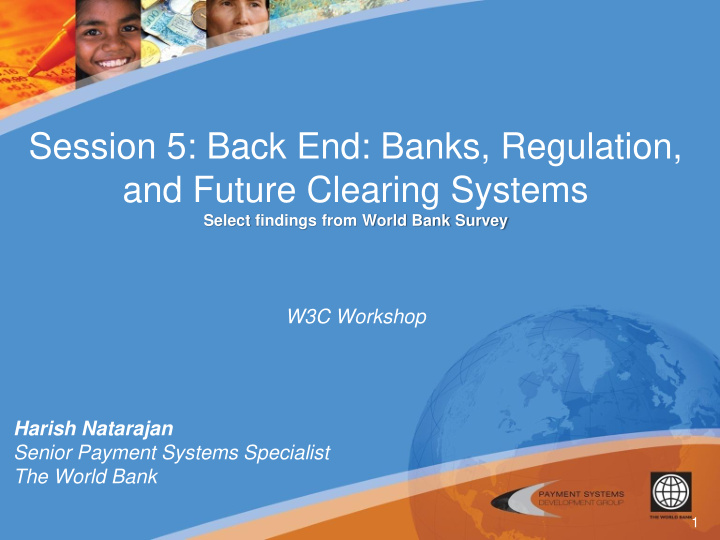



Session 5: Back End: Banks, Regulation, and Future Clearing Systems Select findings from World Bank Survey W3C Workshop Harish Natarajan Senior Payment Systems Specialist The World Bank 1
Key Findings from World Bank Global Payments Survey 2
Innovative Retail Payment Products: Types and Usage 11% Innovative product Number of Category Sub-types transactions account for more than countries 5% of traditional electronic payments Account and balance information 53 Card- stored on a chip card 69% Innovative product Based Card used only for access, balance 58 stored in a central system transactions are growing Account and Balance information in a central system accessed through 43 19% Innovative product Network various channels transactions are growing at a faster Accessed through internet 51 rate than traditional electronic retail Account and Balance information on payments 31 Mobile phone Mobile phone used only for access 33 14% The innovative product is Mobile Billed to mobile phone account 55 the only electronic payment Account information available on instrument they have access to 28 phone. Information used for initiating transaction - akin to contactless card 3
General findings and policy implications for innovative products • Innovative payment mechanisms can be • Innovations could serve to increase understood and analyzed within the affordability and accessibility of payment general framework of the retail payments services system Public Affordability Policy and ease of access Goals Efficient Socially infrastructure optimal mix of to process electronic payment instruments payment instruments • Innovative payment mechanisms • Usage of innovative payments though not fully leveraging existing retail growing is still quite low. This can payments infrastructure – limited contribute to the mix of products; inter-operability and usage of however overall gains to the society clearing and settlement need to be evaluated infrastructure. 4
Inter-operability Inter-operability promotes competition, enables economies of scale and enhances customer convenience; thereby facilitating greater adoption Several levels of inter-operability: Infrastructure level System-wide Cross-system Achieving infrastructure level and system-wide inter-operability with cross system membership (non-exclusivity) might support de-facto cross-system inter-operability. For innovative payment mechanisms inter-operability across payment instruments is also relevant . 5
Infrastructure and access Interoperability of innovative payment products • Information was collected on locations where products could be used and ability to Can be used to pay/receive payments made use products for transfers to using traditional payment schemes customers of other payment products • Most of the innovative Can be used to pay to/receive from payment products are merchants/customers of a few other closed-loop (108 of the innovative schemes 173) products reported. Only 17% were reported having full-fledged interoperability, while 29% Can be used to pay to/receive from merchants/customers of all other innovative have some degree of schemes interoperability • Full interoperability is less common in high-income Can be used only within the same innovative countries, especially ODCs, scheme and somewhat more common in ECA and LAC 0% 10% 20% 30% 40% 50% 60% 70% 6
Infrastructure and access Use of clearing and settlement infrastructure by innovative products Payments are settled in a bank account of the issuer of the monetary value Payments are settled among members of the innovative scheme through correspondent accounts outside domestic PS Payments are settled at accounts maintained at a particular commercial bank Innovative scheme uses domestic interbank payment systems as part of its operations Innovative scheme uses interbank payment systems in another country as part of its operations Payments are settled at accounts maintained in the Central Bank 0% 10% 20% 30% 40% 50% 60% • The traditional clearing and settlement infrastructure is generally not used • More than 50% of the innovative products reported in the survey were settled in the books of the issuer, with only around 24% settling in central bank money • Less than 40% of the products settled in T+0 7
Legal and Regulatory Framework for innovative payment mechanisms 8
Legal and Regulatory Considerations Safety of Customer Funds – operational reliability issues and bankruptcy of issuer. Even where a bank is the issuer, existing treatment for deposit accounts might not be legally applicable to prepaid account. Measures like trust funds, segregation of funds, requiring operational reliability measures etc. can be used to mitigate risk Heightened AML/CFT risks . The way non-bank sets up accounts, operations are overseen and transactions are conducted could create higher AML/CFT risks – but could be addressed effectively through simple measures, e.g. limit transaction size and frequency Weaker authentication could lead to higher fraud risks Consumer Protection. Retail payments raise the additional issue of consumer protection. Independently from the kind of commercial relationship between the service provider and the user of the service, either durable or occasional, rules on transparency and protection of customers must be implemented The profile of customers targeted could be first time users of payment products. Need to ensure they understand the terms and conditions Need to ensure competitive market conditions. Regulation should adopt a holistic retail payments view else it could lead to situations like - banks are constrained with banking regulations and new set of players have relaxed or no regulatory requirements Oversight arrangements. 9
Concluding Remarks Innovative payment mechanisms have a key role to play in advancing adoption of electronic payments and achievement of broader access to payment services. Innovative payment mechanisms need to be seen as an integral part of the national payments system of a country. An appropriate legal, regulatory and oversight framework is essential to ensure achievement of the potential of innovative payment mechanisms . 10
PPP Goals Payment Systems Development Group The World Bank www.worldbank.org/paymentsystems 11
Recommend
More recommend